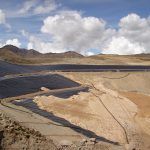WHAT ARE GEOMEMBRANES?
High- or low-density polyethylene Waterproofing Geomembranes are mainly manufactured to prevent the infiltration of any toxic and pollutant substance to the ground and as a waterproof barrier in hydraulic works such as agricultural reservoirs, tanks, channels, treatment plants, evaporation ponds, golf courses, fish farms etc.
GEOMEMBRANE TYPES
- HDPE Geomembranes (smooth and structured)
- LLDPE and VLDPE Geomembrane
ALVATECH GEOMEMBRANES
-
HDPE GEOMEMBRANES
Geomembrana PEAD ALVATECH 5002:
A smooth waterproofing membrane made of high-density polyethylene (HDPE). The specific formulation of this product gives it excellent weldability, enhancing its mechanical properties and chemical resistance.
It is manufactured by a flat die extrusion process (calendering system) using the latest technology, which ensures excellent thickness control and a uniform surface finish (with a slight relief to make the product easier to install on the structure).
The 7.50 m width optimises installation costs and quality control on site, and significantly reduces the number of welding seams required to attach the membrane to the structure, when compared with a narrower sheet.
A waterproofing membrane made of high-density polyethylene (HDPE). The surface is structured on one or both sides, with a large number of spikes (57,000 spikes/m2) over 0.9 mm in height, which makes the membrane extremely stable when waterproofing steep slopes (high coefficient of friction and angle of friction).
We are the only company that offers a structured geomembrane with a width of 7.5 metres, which optimises installation costs as it reduces the number of welding seams required. Recommended for slopes of approximately 20% -12º or more.
-
GEOMEMBRANES LLDPE and VLDPE
LLDPE Geomembrane ALVATECH LLDPE:
A waterproofing membrane made with a formulation based on linear polyethylene which gives it excellent flexibility and weldability.
It is used to seal disposal sites, floating covers and, in general, structures that require a waterproof barrier that is more elastic than high-density polyethylene.
We also offer a structured version: Alvatech® LLDPE FIX, which is structured on one or both sides and is 7.5 metres wide. It has a high coefficient of friction on steep slopes.
VLDPE Geomembrane ALVATECH VLDPE:
A waterproofing membrane made with a formulation based on very low-density polyethylene, which gives it excellent flexibility and weldability. This membrane is even more flexible than the LLDPE geomembrane.
It is used in structures with irregular surfaces, as it can stretch and conform to irregular surfaces. Some examples of these structures include bladder tanks, floating covers, underground structures, green roofs, perimeter kerbs in reservoirs, etc.
Specialities
A waterproofing membrane made of polyethylene (HDPE or LLDPE), bicolour, with a white upper surface and black underside.
The white surface accumulates less heat than a black surface, with a difference between the two of between 20 and 23º C. As a result, it is possible to work for longer periods, and the number of geomembrane waves or wrinkles is reduced.
A waterproofing membrane made of high-density polyethylene (HDPE) or low-density polyethylene (LLDPE) with an additional antioxidant additive package which extends its useful life.
This additional stabilisation means the geomembrane can be used in projects with more abrasive chemical products or more extreme service conditions. The additional antioxidants are more resistant in this type of environment and are retained inside the polymer matrix. Consequently, the mechanical properties of the Alvatech® HP-OIT geomembrane will not deteriorate over time.
A high-density polyethylene membrane designed for applications where the waterproofing barrier has to withstand high temperatures (over 60º Celsius).
It is mainly used in food industry processes, hot springs, wastewater treatment, etc.
Alvatech® Colour geomembranes are specifically designed to enhance the surroundings and reduce visual impact. They are most commonly used for: landscaping and garden projects, waterproofing artificial snow ponds, reservoirs, canals, ornamental lakes, tunnels, and galleries etc.
The Bioleaching Membrane, also called Termofilm, is a polyethylene sheet, used in low-grade mining in bioleaching processes of sulphide metals. The sheet is placed on the dripper network and the benefits it provides are:
- Encourage microbial activity during the leaching of metals, since it maintains the temperature in the mineral piles, achieving higher yields.
- Avoid strong evaporation from drip irrigation in mineral piles as the vapours condense on the film and fall back to the ground.
A waterproofing membrane based on the EVOH ethylene copolymer, which is specifically designed to act as a radon gas barrier, preventing the harmful gases from entering buildings.
-
Conductive Alvatech
A waterproofing membrane made of high-density polyethylene (HDPE) or linear low-density polyethylene (LLDPE), with a structured or smooth surface.
The underside has a fine conductive film, which allows the air and watertightness of the geomembrane to be easily tested in two ways: 1) The Spark-Test method, in accordance with the ASTM D 7240 standard, after the geomembrane has been installed on site and the surface has not yet been covered. 2) The Electric Dipole method, in accordance with the ASTM D7007 standard, after the installed geomembrane has been covered with water or minerals.
APPLICATIONS OF THE GEOMEMBRANES
- Hydraulic
Reservoirs: for agricultural irrigation, golf courses, in high mountains for artificial snow, solar thermal plants, hydroelectric power plants, and other industrial applications.
Canals: agricultural irrigation, inter-basin transfers, etc.
Aquaculture: Intensive production of shrimp and tilapia, is done in shallow ponds.
Floating covers: to eliminate evaporation, preserve water quality. And also, to deodorize waste ponds and capture methane from organic waste.
- Environment
Landfills: municipal landfills for urban waste, manure heaps for agricultural holdings, industrial warehouses, …
Thermal Power Plants: design of discharge cells to store the ashes resulting from the combustion of coal in thermal power plants safely and efficiently.
Industrial Treatment Plants: e use of geosynthetics in industrial treatment plants and evaporation ponds is applied to dehydrate the waste that will later be taken to the landfill.
- Mining
Waterproofing heap leach pads in leach mining (Au, Ag, Cu…) and non-leach mining (I, Li,) to optimise extraction performance.
- Construction and Roads
Roads and railway tunnels. Waterproofing building foundations to prevent damp, and to act as a radon gas barrier.
ADVANTAGES OF THE USE OF WATERPROOFING GEOMEMBRANES
- High chemical resistance. Possibly the polymer with the highest chemical resistance to attack by acids, alkalis, organic and inorganic solvents.
- High mechanical resistance in a wide range of temperatures.
- Durability, numerous studies show that the useful life of the HDPE geomembrane is well over 100 years, even when exposed to the elements.
- Possibility of verifying the tightness to the welds.
- The use of large sheet widths reduces the number of welds on site.
- Flexibility and versatility in a wide range of applications.
- Very competitive cost of product and application.
- Recommended for drinking water.









